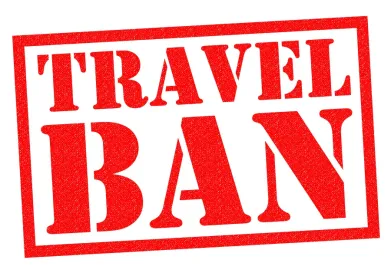Significant confusion has arisen in the week since President Trump issued his Executive Order (EO) entitled Protecting the Nation from Foreign Terrorist Entry Into the United States on January 27, 2017. Our previous summary can be found here. Following a frenetic week at U.S. ports of entry and international airports and increased litigation in several federal district courts, the EO’s worldwide implementation was temporarily halted by a federal judge’s temporary restraining order (TRO) on Friday, February 3, 2017. The case is now before the Ninth Circuit Court of Appeals which, on Saturday, February 4, 2017, denied the government’s emergency request to set aside the stay. The Court of Appeals is expected to issue another preliminary decision in the coming days.
So, where are we today and what is the current state of the EO and the respective travel ban? This post addresses several key areas of continuing concern and confusion among employers and individuals subject to the travel ban.
What did the judge’s ruling do to the EO?
U.S. District Judge James Robart, of the U.S. District Court, Western District of Washington, granted the TRO at the request of the States of Washington and Minnesota and implemented his ruling on a nationwide (and effectively, a worldwide) basis. The TRO temporarily freezes further enforcement of the following provisions of the EO:
-
Section 3(c) – 90-day travel ban on immigrants and nonimmigrants from the 7 designated countries (Iran, Iraq, Libya, Somalia, Sudan, Syria, and Yemen):
-
Section 5(a) – 120-day ban on U.S. refugee program;
-
Section 5(b) – Prioritization of certain refugee claims;
-
Section 5(c) – Indefinite suspension of Syrian refugee admissions; and
-
Section 5(e) – Case-by-case refugee admissions.
This post will address the impact of the Section 3(c) travel ban.
The executive agencies tasked with enforcement of the EO, including the Department of State (DOS), in charge of issuing visas and vetting of visa applicants, and the Department of Homeland Security (DHS) Customs and Border Protection (CBP), in charge of enforcing the travel and entry bans, have committed to temporarily returning to the “standard policy and procedures” used prior to the EO. In the ensuing days, various nonimmigrants and immigrants, including refugees, have been issued new visas, had provisionally revoked visas reinstated, and gained entry to the United States.
What countries are covered by the EO? Could that change?
Iran, Iraq, Libya, Somalia, Sudan, Syria, and Yemen are the original seven countries listed in the EO, but the administration hinted that additional countries could be added to the list. However, recent statements by the DHS infer no new additions to the list are contemplated in the near future. Of course, a new EO or other executive action could always expand the travel ban’s reach.
How does the EO affect Lawful Permanent Residents (Green Card Holders)?
The EO’s language applies to immigrants and nonimmigrants. The former are people coming to live “permanently” in the U.S., including lawful permanent residents (aka green cardholders). The latter are those temporarily entering for employment, schooling, business or tourism, among other categories. In the first few days of the EO’s enforcement, several green card holders were detained or denied entry to the United States and, in some cases, asked to relinquish their green cards. The Department of Homeland Security eventually determined that green card holders are not subject to the EO, and during several days prior to the TRO, had permitted entry of green card holders from the seven designated countries.
How does the EO affect dual citizens who are citizens of at least one of the designated countries?
Similar to the situation with green card holders, individuals who are dual nationals from at least one of the seven designated countries were initially barred entry and denied visas under the EO. Initially, the Trump Administration enacted a patchwork program of assuring certain countries (E.g, the UK, Canada, and Australia) that their dual nationals traveling from the non-designated country and using the non-designated country’s passport, would be permitted to obtain visas and travel to the U.S. Other traditional allies, such as Germany and France, did not receive the same assurances, leading to confusion and unequal implementation of the EO across various U.S. Embassies and Consulates.
Last week, the DHS and the DOS both announced that the EO does not apply to dual nationals if the individuals are able to travel on the non-designated country’s passport. So, a dual UK-Iranian citizen should be fine to obtain a U.S. visa and enter the U.S. using their UK passport.
What does it mean to “provisionally revoke” visas and who was affected?
During the EO’s first week of enactment, the Department of State “provisionally revoked” the valid visas of approximately 60,000 individuals from the seven designated countries (earlier reports mistakenly reported 100,000 visas). Provisional revocation is a seldom-used action that allows for the temporary invalidation of visas without case-by-case review or physically altering the visa in a passport. So citizens of the seven designated countries with a valid U.S. visa could no longer use that visa, because it had been provisionally revoked by the EO.
Will those whose visas were provisionally revoked have to apply for a new visa?
As its name suggests, provisional revocation is not a permanent revocation, and as such, can be reversed without the need for the applicant to reapply for a new visa, as is the case for someone whose visa has been revoked under traditional, non-provisional means. Following the TRO on Friday, the DOS was working to reinstate provisionally revoked visas and many of the citizens of the seven designated countries that are now entering the U.S. are using visas they already help prior to the EO. In addition, DHS was issuing waivers to individuals whose visas had physically cancelled to allow them to enter the U.S. on those same visas without the need to reapply.
How does the ban affect people already in the United States on January 27, 2017? Are they deportable? Can they continue to work under previous visas and other means of employment authorization?
To date, there have been no reported cases of citizens of the seven designated countries already legally in the U.S. prior to the EO’s issuance being placed in removal proceedings or deported. DHS has publically stated that the EO does not affect those already in the U.S., but opponents of the EO point out that the president’s broad immigration authority likely allows him to remove people under the EO. To date, we have seen no indication that the administration is moving in that direction, although the increased vetting and background check procedures established by the EO could always lead to new information on individuals already in the U.S.
For employers, there is no need to re-verify employment authorization or treat existing employees from the seven designated countries any differently. This is especially true now that the EO has been suspended.
What happens if someone subject to the ban was already in the U.S. and decides to leave?
As of February 6, 2017 and while the TRO is in effect, there should be no repercussions for anyone from the seven designated countries traveling abroad and returning to the U.S. under standard laws and procedures. However, given the temporary nature of the TRO, and the fact that it could be overturned at any point, travelers from the seven designated countries should be wary of departing the U.S. If the order is lifted while they are outside the country, it is possible that they may find themselves stranded for quite some time.




 />i
/>i

